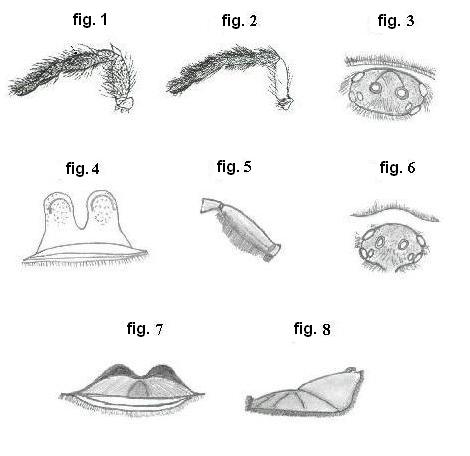Subfamily Ornithoctoninae (Pocock, 1895)
Identification keys of genera of Subfamily Ornithoctoninae
(By: B.K. Tikader. Handbook Indian spider. Zoological Survey of India, 1987, Calcutta)
The representatives of subfamily Ornithoctoninae are characterized with the following taxonomical features: stridulating organ is presented between the chelicerae and coxa of palp and outer surface of chelicerae covered with scopula or a pad of feathery hairs. Chelicerae of these spiders are furnished externally with dense pad (scopula) which are composed of short, close set plumose hairs. Between the scopula and the oral fringe, there is a naked area, which, however, bears posteriorly a small number (about four) of large, slightly curved, plumose bristles springing from the scopula above.
Inner surface of maxillae are sparsely hairy, but furnished both above and below the suture with a small number of black tooth-like tubercles. Posterior sternal sigillae are remote from the margin.
Legs are with a few spines at apex of tibiae and tarsi, tarsal scopulae are thick and undivided.
|
Key |
Features |
Key or genera name |
|
1 |
Tibia of leg IV thickened, swollen (fig. 1) |
|
|
|
Tibia of leg IV unthickened (fig. 2) |
2 |
|
|
Carapace low. Ocular tubercle close to edge of clypeus (fig. 3). Spermathecae divided with two denominated receptaculae (fig. 4) |
6 |
|
2 |
There're no tibial spur of leg I. Palpal femur do not have lateral pads, formed with long, thick hairs. Clypeus narrow. Ocular tubercle wide |
|
|
|
Male tibia of leg I with a spur (hooks) |
3 |
|
3 |
Palpal femur do not have lateral pads, formed with long, thick hairs |
Cyriopagopus |
|
4 |
Palpal femur do not have lateral pads (fig. 5), formed with long, thick hairs. Legs slender |
Lampropelma |
|
5 |
Clypeus wide, legs strong and short. Ocular tubercle narrow (small). Thoracic fovea large and scarcely procurved |
Ornithoctonus |
|
6 |
Carapace increased (raised) at anterior part (caput clear visible). Ocular tubercle distinguished from the clypeus edge (fig. 6) |
- |
|
|
Spermathecae of primitive type, not divided. Receptaculae semini in most cases weakly denominated (fig. 7). Ocular tubercle small and narrow. Caput stand out and clearly seen (fig. 8). Thoracic fovea small and concentric |
Haplopelma |
